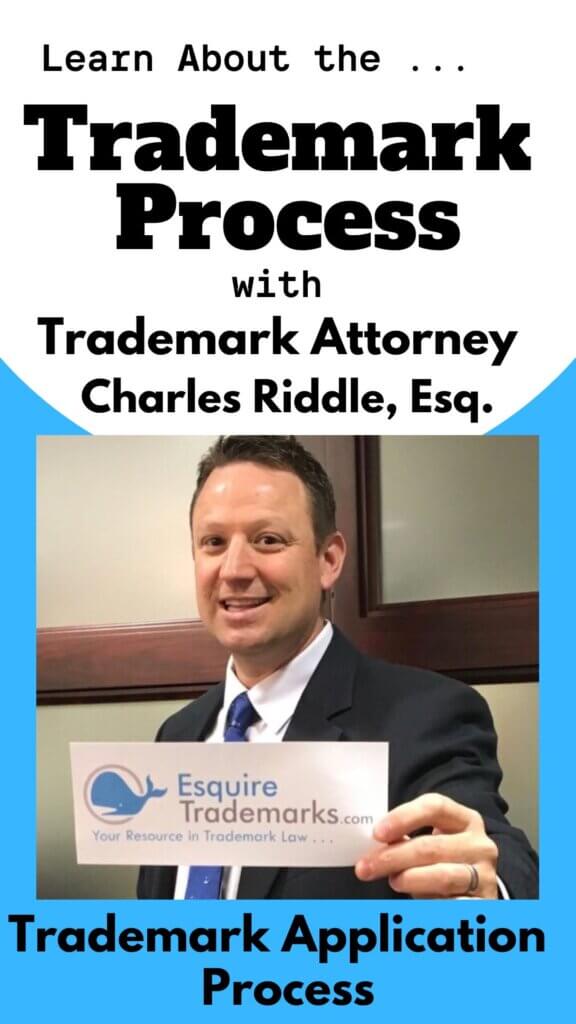What Is the Trademark Process and Timeline for Your Trademark Application?
The trademark process and timeline described below sets out the general path a trademark application takes in its lifecycle. Registering a trademark or trademarking a logo is a legal process. As a legal process, the trademark application path can take many turns subject to legal advocacy, statutory interpretation, introduction of argument and evidence. That’s why it’s important to benefit from the experience of a licensed attorney. With 20+ years experience in trademark law, we anticipate the common problems associated with registering a trademark, provide advice, and incorporate trademarking strategies into the application process.
Before the application is prepared and filed, we interview and consult with you. We discuss the various options, risks, and benefits that are presented with your trademark situation. We will will provide you with guidance and feedback regarding your trademark. We endeavor to provide you with a full and clear picture of what you can expect in the trademark process. With 20 years experience in trademark law and litigation, we can anticipate most issues and craft the trademark application in a way that avoids most rejections and refusals.
Once Your Trademark Application Is Filed, the entire trademark process takes 10-12 months. Office actions and third party oppositions can extend this timeline significantly. We keep you informed of the developments regarding your trademark application as it moves through the process. Below are the various steps involved in the trademark process.

Step 1 of the Trademark Process: The Initial Search and Trademark Consultation With a Licensed Trademark Attorney
We discuss the various options, risks, and benefits that are presented with registering your trademark based on the information provided by the client. We perform a knock out trademark search to determine if you have any chances at registering the trademark. We then discuss the legal concept of likelihood of confusion and how similar marks can block the trademark application under the trademark laws. We then discuss common trademark law rights and how they can affect your trademark application. We screen the mark for absolute grounds for rejection such as genericness, descriptiveness, surnames, deceptiveness, and others. We evaluate your proof of use of the mark and determine whether the application should be filed as intent to use trademark application.
The consultation is a result of interpretation of the trademark statute and case law and analysis of the facts of your proposed trademark relative to the current trademark laws. This legal consultation regarding the trademark application is something only an experienced and licensed trademark attorney can perform. With over 20 years experience in trademark law, we provide an efficient consult in a short period of time.
We endeavor to provide you with a full and clear picture of what you can expect in the trademark process. We want you to be aware of the trademark registration process, so you know what to expect. We educate you as to (1) how the trademark statute works, (2) what rights you have, (3) what rights you can obtain through trademark application process, (4) the legal risks of your trademark application being challenged. Based on the consultation, together, with advice and analysis from the trademark attorney, we come up with a plan for registering your trademark.
Step 2 of the Trademark Process: Trademark Application Is Filed – Application Filing Receipt
- Once the trademark Application is filed, you will receive a letter and filing receipt from our office confirming the trademark application was filed. The letter and filing receipt will identify your trademark by name, application number and filing date.
- You can expect to wait 10 months before you hear anything further from the trademark office. During this period, the trademark application will undergo examination by an Examining Attorney at the Trademark Office. This is the longest wait in the trademark process.
- You can check the status by entering the Application’s serial number into the USPTO’s Trademark Electronic Search System(TESS).
- As the attorney of record, we will receive all official correspondence from the Trademark Office regarding your application. We will then report this information to you.
- TRADEMARK OFFICE SCAMS – BEWARE! You will receive trademark scam solicitations by mail and email. DO NOT RESPOND TO ANY SOLICITATIONS YOU RECEIVE FROM OTHERS. EVERYTHING RELATED TO YOUR TRADEMARK APPLICATION WILL COME FROM OUR OFFICE.
Step 3 of the Trademark Process: Examination by the Trademark Office
- It takes about 10 months from the filing date to have the application reviewed by the Trademark Office.
- At this point in the trademarking process, an Examining Attorney reviews the application to determine if it would be allowable under the Trademark Statute and associated Regulations.
- The most common grounds for rejection are prior filed registrations/applications; the mark is generic/descriptive; the mark includes someone’s name.
- Other grounds for rejection relate to the description or classification of goods and services.
- Yet, other grounds for rejection concern the specimen of use (evidence showing the mark being used with the goods/services).
- Not to worry, we evaluate your trademark prior to filing. In most cases we anticipate the above rejections and discuss the risks with you. In few instances, an unexpected rejection can occur.
Step 4 of the Trademark Process: Trademark Office Action / Rejection Stage
- An Office Action will be issued, if the Trademark Office finds grounds for rejection or refusal. The response time for the Office Action is Six months. For office actions dated after December 4, 2022, the time to respond to the rejection is 3 months.
- You will receive a letter from our office explaining the issues and providing a cost and the time for responding. With your approval, we will proceed to prepare and file the appropriate response/request for reconsideration. The application goes abandoned if no response is filed.
- Often, the Trademark office withdraws some or all of the rejections. This is a result of the Applicant resolving the issues in the response. Or, the arguments made in the request for consideration were persuasive.
- If the response and arguments are found unpersuasive, we will receive Final Office Action. We will then have a six-month window to respond with arguments or amendments to the application. If we receive a Final Office Action, we will discuss with you the options for abandoning, re-filing a new application, or appeal.
Step 5 of the Trademarking Process: 30-Day Publication of the Trademark Application for Opposition
- If the office action is resolved, or there were no rejections, the application gets published for opposition. We receive a Notice of Publication, and about 2 weeks later, the application is published in the Official Gazette. A confirmation email is sent to our office.
- Other brand owners have 30 days from the date of publication to oppose the trademark application. If a notice of opposition is filed, your trademark application will be suspended until the opposition proceeding is resolved. If the trademark application is not opposed within 30 days, the application will move to registration as a U.S. Trademark.
Step 6 of the Trade Mark Process: Statement of Use for Intent-to-Use Trademark Applications
If You Filed an Intent to Use (ITU) Trademark Application, a Statement of Use (SOU) Is Required
- Before the Trademark registration is granted, the applicant must submit evidence showing how the trademark is being used. Applicants must also provide a sworn declaration that the mark is being used with the goods/services listed in the trademark application. This is called a Statement of Use (SOU).
- This requirement to file a SOU is triggered by a Notice of Allowance (NOA). The Notice of Allowance states that a trademark is allowed for registration. Our office receives the NOA and we will send you a letter reciting the requirements and associated steps or procedure with the NOA stage.
- This section only applies to 1(b) ITU Applications. So, what is Intent to Use (ITU) Trademark Application? An ITU application means you filed for a trademark before you began using the trademark. ITU applications differ from 1(a) “use in commerce applications.” When you file a 1(a) application, you submit the evidence of use (specimen of use) and verified statement of use (SOU) with the original application. If you filed an ITU, the statement of use is filed after examination of the application. If you are not sure which application was filed, refer to your trademark application filing receipt, or contact us.
- After a NOA is issued, Applicant has 6 months from the date of the NOA to file a SOU. If you are not yet using the mark, you may request an Extension of Time to File SOU. Applicant may file a total of 5 requests for Extension of Times to File a SOU. A new request for Extension of Time to File a SOU must be filed every 6 months. The deadlines for filing a SOU or request for Extension of Time to File a SOU is measured in six-month increments from the issue date of the NOA. Finally, a SOU may not be filed more than thirty-six months from the original NOA date.
Step 7 of the Trade Mark Process: Trademark Registration Certificate Is Issued
- The trademark certificate issues about three months from the Notice of Publication. If there are no office actions or oppositions, the entire process – from application to registration – takes 10 to 14 months. But, it can take longer if you filed an Intent to Use Trademark Application.
- The registered trademark gives the owner particular rights. The trademark registration is effective to block others from registering your mark in the same category. The courts and others (online retailers such as Amazon.com) presume that you own the trademark, and that the mark is valid. The trademark is effective nationwide (all 50 states and US territories).
- In order to keep the Registration, it must be maintained by filing various declarations.
Maintenance and Renewal of Trademark Registrations
- The main requirement to maintain trademark rights is use in commerce. The owner must use the mark with the goods/services identified in the trademark registration.
- The owner must file a sworn declaration and provide evidence of continued use between the 5th and 6th year after the Registration issues. At this point in time, the recommended filing is the Combined Section 8 & 15 Declaration.
- Further the owner must file renewal trademark applications between the 9th and 10th years, and before every subsequent tenth year after the Registration issues. At this point in time, the recommended filing is the Combined Section 8 & 9 Application for Renewal.
Look Out For Trademark Scams
- When registering for a trademark, you will likely receive multiple trademark office scams. These are often disguised as official notices from the USPTO.
- If you receive any notices like this, contact your trademark attorney immediately. If the notice is not sent by your Attorney of Record, do not trust it.
- See our article for more information on trademark office scams.
Applicant E-Mail Addresses Are Required
- Applicants must submit their e-mail address along with their trademark registration.
- Fraudulent Official Notices use public e-mail and postal addresses that the trademark application forms provide, making you vulnerable to trademark scams listed above.
- Fraud criminal enterprises will send phishing fraud scams by e-mail. EsquireTrademarks.com uses a dedicated spam e-mail address to protect you from these scams.
- See our post on Trademark Fraud Using Public E-mail Addresses for more information.
The Trademark Process may seem complicated or daunting at first glance, but EsquireTrademarks.com is here to guide you through it. Contact us today for your trademark consultation.
